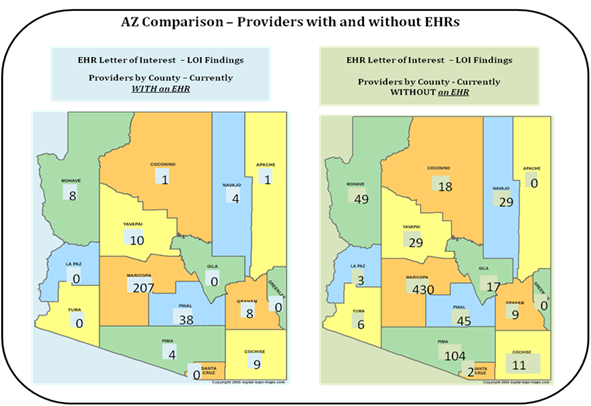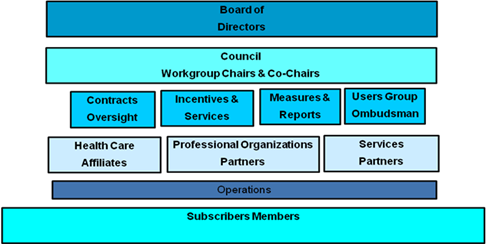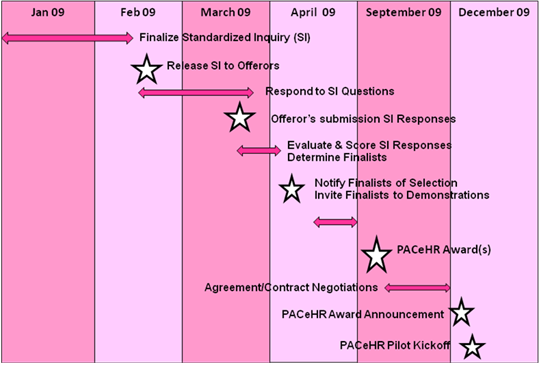
5.1 Project Initiation
The desire to collaboratively
foster EHR adoption in Arizona is not new. As early as ten years ago, small
groups of forward-thinking providers, employers and health plans had piloted
various EMR adoption efforts, in the "pay for use" precursor to
"pay for performance." Most recently, the Arizona Health e Connection
board of directors obtained a favorable legal opinion regarding their
collective ability to create a joint incentive pool for this purpose. So it is
upon this rich foundation of collaboration and innovation that the EHR
collaborative was born. The vision and support of AHCCCS Director Anthony
Rodgers gave substance last year to the Arizona EHR Collaborative Purchasing
Program (CPP). This enterprise evolved into the Purchasing and Assistance
Collaborative for Electronic Health Records (PACeHR) funded by the Medicaid
Transformation Grant and in-kind funding. Monies were used to create the
project plan; design the proposal request for proposal (Standardized Inquiry)
for PACeHR's web-based EHR, including evaluation tools and processes;
orchestrate EHR procurement and vendor selection from 16 proposals using an
innovative process with external oversight from Gartner that included 19
volunteer providers and subject matter experts (IT, law, and business) and
provided opportunity for community participation in the demonstration and
selection process.
5.2 Requirements Definition
The requirement of the EHR
project was to develop a collaborative that would provide products and services
to small and medium-sized primary care healthcare providers as a means to
accelerate the adoption of EHRs.
5.2.1 Environmental Scan and Needs Analysis
In order
to determine the needs of practitioners who would utilize the service and the
current landscape of EHR use in Arizona, PACeHR utilized data from two Arizona
surveys and information from Health-e Connection (AzHeC) detailed below.
First, AHCCCS sponsored a study conducted by The Center for Health Information & Research (CHIR) in which CHIR collected responses submitted by Arizona providers from a survey that was distributed as part of their license renewal process (Appendix A). The study was conducted over a two-year period between 2007 and July 2009 in order to allow for a complete renewal cycle. Interim reports were prepared with the final report expected in 2010. The purpose of the study was to capture the use of EMRs by Arizona providers as well as physicians’ attitudes toward a HIE. Findings listed in the most recent report include:
Use of EMRs/EHRs
The second survey administered was specifically designed to address EHR use and perceived needs of an organization to facilitate EHR adoption (Appendix B). It was created and then disseminated through local provider organizations during the last quarter of 2008. Over 1,100 Arizona clinicians from more than 300 practices responded by completing (on line or fax) the EHR Collaborative Purchasing Program Letter of Interest (LOI). The majority of respondents (72%) did not have an EHR. EHR owners, however, expressed interest based on a less than satisfactory EMR experience, and/or desired access to the other features of PACeHR.

In addition, the EHR Collaborative Purchasing Program Letter of Interest garnered valuable data; its responses also indicated:
Arizona´s small to medium size practices were interested in collaborative EHR system purchasing
The third contributor to PACeHR´s needs assessment originates from AzHeC. AzHeC is a not-for-profit organization whose mission is to lead Arizona´s establishment of health information exchange (HIE), and adoption of health information technology (HIT). AzHeC created a five-year "Roadmap" to establish Arizona´s health information infrastructure. The "Roadmap" for health information infrastructure also emphasized the need for EHR adoption in order to have integrated statewide health information systems and data exchange because EHR use is the foundation of effective health information exchange.
The survey results and Health-e Connection report assisted in identifying provider requirements for EHR and determining the strategy for supporting EHR adoption.
5.3 Development
The project team and consultants
determined that as the initial focus, a web-based strategy was the most
flexible EHR solution to meet the needs of providers across Arizona because few
hardware and software resources would be required compared to an in office
server based solution. PACeHR was formed to provide EHR services and
implementation assistance to small and medium sized practices. The organization
facilitated due diligence required to select technology & service providers
through a research and analysis process that is typically unachievable by this
size practice.
5.3.1 PACeHR Formation
Although PACeHR´s roots
originate from AHCCCS (Arizona´s sole Medicaid Agency), the Project Team
and Director of AHCCCS recognized that PACeHR´s success – and the
success of EHR use – depended upon a larger audience than just AHCCCS
providers. Provider feedback stressed their need for one system that could
accommodate both AHCCCS and non-AHCCCS patients. Physicians and providers did
not want to use one system for AHCCCS patients and a different system for all
other patients. This was the key reason that PACeHR separated from AHCCCS.
PACeHR incorporated as a 501c3 (non-profit) corporation on June 12, 2009.
PACeHR´s organizational structure was founded for the purpose of governance and business operations and is displayed in Figure 1. The Team established a mission and vision for PACeHR that every Arizona clinician will have access to an affordable, interoperable, web-based electronic health record solution that includes support and related services. PACeHR planned to leverage web-based technologies, economies of scale, aligned metrics, and strategic partnering to improve quality, safety and efficiency while promoting a community of information sharing through the use of health information technology & electronic access to data.

5.3.2 Vendor Selection Process
PACeHR also needed to
construct a process to select EHR vendors. First steps included assembling an
evaluation panel to assist with EHR vendor review and selection. Their roles
and responsibilities included participating in the Offeror´s detailed
reviews of SI responses and providing feedback for EHR finalist demonstrations.
Members of the Evaluation Panel are listed in Table 2
Table 2 PACeHR Vendor Evaluation Panel
| Arizona Medical Association. | AZ Osteopathic Medical Assn. |
| American Academy of Peds.- AZ Chapter | AZ Health Care Assn. |
| American Coll. of Obstet. & Gyn.- AZ Chapter | AZ Health-e Connection |
| American Coll. of Physicians-AZ Chapter | Health Services Advisory Group |
| Medical Group Mgmt. Assn.- AZ Chapter | Maricopa County Medical Society |
| AZ Healthcare Info. Mgmt. Systems Society | AZ Nurse Practitioners Council |
| AZ State Assn. of Physician Assistants | AZ Dental Assn. |
| AZ Latin-American Medical Assn. | Pima County Medical Society |
| AZ Partnership for Implementing Pt. Safety | AZ Hospital & Healthcare Assn. |
| AHCCCS health plans & contractors | |
To enable an appropriate due diligence process, tools listed below were created to identify the EHR functionalities and services that PACeHR would support. Requirements for a web-based EHR system were communicated through a Standardized Inquiry (SI) / Request for Proposal process for interested vendors. The process of developing the SI was lengthy, and required substantial legal input due to contract requirements of AHCCCS. Interested EHR companies were to provide a written response in the designated format and present (if selected as a finalist) demonstrations of the products(s) being offered that best fulfilled the requirements of the SI. The full SI is attached. Main components included:
Processes and tools to evaluate, vet, and select EHR software vendors and Information Technology partners were applied by the Panel to the vendor selection and included:
Gartner, a nationally-known expert in healthcare and information technology consulting, provided project oversight throughout the evaluation process. Gartner was actively involved in the due diligence applied to the processes. Upon completion of their work with PACeHR, Gartner issued a white paper inspired by the experience.
The complete evaluation process is illustrated in the attached diagram.
The process of developing PACeHR and vendor selection was complex and the time from developing the organizational structure to selection of vendors took well over one year. The timeline for SI development and vendor selection is illustrated in Figure 2
Figure 2 PACeHR Timeline for Electronic Health Record Vendor Selection

5.4 Implementation of PACeHR
The PACeHR implementation
strategy was to roll out the PACeHR product in phases – each with
specific guidelines, options, and goals – but all within the PACeHR
Implementation Framework. The phases – Pilot, Early Adopters, and Full
Rollout – are structured to gradually implement the PACeHR EHR products
while establishing the implementation and support processes that are needed to
implement and manage a high volume of EHR implementations simultaneously over a
short time period. The PACeHR Pilot Program will be crafted during the initial
PACeHR ´:new company´ timeframe of July through December 2009,
with implementation for the pilot beginning in late December / early January.
PACeHR will also use the pilot providers as the marketing and user group
nucleus that will be the foundation for PACeHR strategies going forward.
5.4.1 Project Background and Purpose
PACeHR, acting as
a broker on behalf of its member subscribers, negotiated group purchases
including discounts and other incentives to make EHR-related software,
hardware, training, and services affordable and predictable. Through the
American Reinvestment and Recovery Act (ARRA) of 2009, significant Federal
funding has been committed to assist health care providers that adopt and
achieve meaningful use of EHRs. However, to receive this funding support and
achieve meaningful use will require resources that not all small to medium size
practices have available. PACeHR will provide these resources & support for
practices to achieve ´meaningful use´ as defined by the Federal
government. To the small and medium size practice, these criteria are critical
yet difficult to achieve without ongoing support and guidance.
5.4.2 Pilot Program Scope and Objectives
The PACeHR
Pilot Program is in the process of defining, establishing, and testing the
pre-implementation and implementation processes and procedures for how multiple
organizations (PACeHR, EHR vendors, Support / Managed Services organizations,
provider practices) work together to effectively purchase, implement, &
maximize EHRs in small to medium size provider practices. The pilot will also
use and evaluate externally provided training resources.
The PACeHR Pilot Program has the following goals and objectives:
This Pilot Program will provide critical information on how effective and useful a collaborative approach to EHR implementation is as it has not previously been attempted on a statewide level. PACeHR the organization has aggressive EHR implementation goals, which cannot be met without efficient implementation strategies. The results of the pilot program will drive the implementation strategies applied to the Early Adopter and Full Rollout plans for PACeHR.
5.4.3 Pilot Program Sites
The PACeHR Pilot Program is
establishing what needs to occur to implement EHRs on a high-volume scale with
a high level of support services at less than market / retail cost. The
selection of Pilot sites required interested practices to submit a Nomination
Packet and commit to adhere to program requirements. The PACeHR evaluation
staff reviewed & presented finalists to the PACeHR Board of Directors for
final approval. The first pilots are implementing in the first quarter of
2010.
5.4.4 Pilot Deliverables
The PACeHR Pilot Program is
establishing the processes and infrastructure that will be applied by PACeHR as
the EHR products and services are solidified and made available on a large
scale. The PACeHR Pilot Program deliverables include the initial frameworks for
the following:
The Pilots are in the implementation phase; therefore the above deliverables will be updated and refined as lessons are learned. It is expected the pilot will produce significant documents for the above noted information / deliverables. The evaluation process will occur at 6-month increments and the metrics to be used will be defined throughout the pre-implementation process. The pilot will also produce tools and processes needed to manage the PACeHR project on a larger scale. (Appendix I – PACeHR Pilot Mgmt Plan – contains project plans/tools used to manage the Pilot Program.)
5.4.5 Pilot
Management
Management of pilot implementations will be
two–fold. PACeHR will have responsibility for the overall implementation
plan and schedule, and EHR vendors will each manage detailed implementations
for their respective organizations. Other PACeHR staff (and workgroup
participants) will participate, as will additional resources from external
entities that provide EHR pre–implementation services. Once selected, the
practices will be oriented to the PACeHR program, plan, and processes and
resources will be assigned. Oversight of the pilot program will be the PACeHR
Board of Directors.